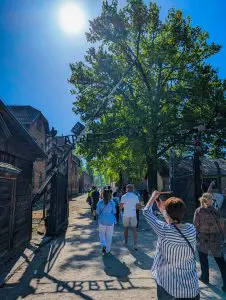 The way we travel and what we choose to see, can vary widely depending on a number of factors. You may be the kind of traveller who enjoys heading to the beach and relaxing for a week. Or like us, you may use your time to delve in the culture and history of the place you’re visiting.
The way we travel and what we choose to see, can vary widely depending on a number of factors. You may be the kind of traveller who enjoys heading to the beach and relaxing for a week. Or like us, you may use your time to delve in the culture and history of the place you’re visiting.
We love a city break, and our fondness has only grown the more we have visited various places in Europe. Having found incredibly cheap flights and accommodation, we decided to head to Krakow, Poland in April 2024. This is a city we have been eager to visit for a very long time, because not only does it have a rich cultural history, but it was also involved in many pivotal moments in World War II. After we booked the trip, our next consideration was what we would see when we were there, and for many (including us) Auschwitz and Birkenau was at the top of the list.
We’re sure that many of you know the horrendous history of the Auschwitz and Birkenau concentration camps, but for those who don’t, we will provide a little more detail below. Although for some, the thought of visiting can be distressing, but we wanted to pay our respects to the many people who died and suffered in both camps. There is something visceral when you walk around the site, a feeling of sadness as you’re told the horrors that occurred. We also found the experience to be highly respectful and informative, but even if you choose not to visit, there is still plenty to see and do in Krakow.
Ad Disclaimer!
This website uses paid adverts and affiliate links, these come at no additional cost to you and help us to fund the operation of the website, meaning we can continue to provide you with valuable content.
The money received from these links and adverts do not influence any recommondations made within our content.
Page Contents
Brief History of the Auschwitz and Birkenau Concentration Camps
Most people know about the atrocities in concentration camps across Europe during World War 2. Auschwitz-Birkenau was the largest concentration and extermination camp built by Nazi Germany from 1940 to 1942. It was located in Southern Poland in the suburbs of Oswiecim and consisted of three camps for imprisonment, extermination and forced labour. Although there were various prisoners held in the many concentration camps built by the Nazis, Auschwitz was predominantly used for Jewish citizens. The estimated number of victims who died in the camp is between 1.1 and 1.5 million, with 90% being Jewish.
Able-bodied Jewish prisoners were used within the camp as slave labour. Whereas the weak, disabled, aged and even children and mothers were killed in the purpose-built gas chambers, which was in line with the Nazi’s final solution plans to murder European Jews. Other prisoners were subjected to medical experiments by the monster Josef Mengele.
 The camp is sectioned into four areas, with Auschwitz I being the oldest and known as the main camp, holding between 15,000 and 20,000 prisoners. The second part is in the Birkenau camp known as Auschwitz II which held over 90,000 prisoners, but it was also the area of mass extermination with the majority of victims being murdered there. More than 40 sub-camps can be found in Auschwitz III and this is where prisoners were kept for slave labour. Finally, the Interessengebiet was an area of approximately 40 square kilometres, which lay around Auschwitz I and Auschwitz II-Birkenau camps. Although areas of the camp were destroyed by the Nazis towards the end of the war. What was left has been converted into a museum and memorial, which was given UNESCO World Heritage Status in 1979.
The camp is sectioned into four areas, with Auschwitz I being the oldest and known as the main camp, holding between 15,000 and 20,000 prisoners. The second part is in the Birkenau camp known as Auschwitz II which held over 90,000 prisoners, but it was also the area of mass extermination with the majority of victims being murdered there. More than 40 sub-camps can be found in Auschwitz III and this is where prisoners were kept for slave labour. Finally, the Interessengebiet was an area of approximately 40 square kilometres, which lay around Auschwitz I and Auschwitz II-Birkenau camps. Although areas of the camp were destroyed by the Nazis towards the end of the war. What was left has been converted into a museum and memorial, which was given UNESCO World Heritage Status in 1979.
Booking Your Visit to Auschwitz-Birkenau
After organising our flights and accommodation, we set our focus on the things we wanted to do during our trip to Krakow. We have written a comprehensive guide on the Best Things to do in Krakow, which will make planning your city break there even easier.
Ironically, we mentioned to a friend who had just been to Krakow that we had booked, and she strongly recommended pre-booking the Auschwitz tour. We still had 4 weeks before flying and yet many of the tours were already booked up well in advance. So, our first top tip is to arrange your tour as soon as you book your trip, because it will fill up fast. As you can imagine this is one of the most popular things to see in Krakow, so if it’s a big item on your bucket list then book as a priority.
There are lots of companies offering tour guides, but we used Auschwitztour.co.uk who have a variety of options including visiting Auschwitz and the Salt Mines. It’s important to note here that although you can visit the camp independently, we would strongly recommend using a tour guide to experience this properly. The site is about an hour and a half drive from Krakow, as such it’s not easily accessible for most of us visiting the city.
Should you choose to go on your own, we would recommend checking out prices on the official Auschwitz-Birkenau site. The museum is free to enter, the cost is to pay for the tour guide. If you want to walk around without a guide, then there are specific time slots which are normally in the late afternoon. We would recommend prebooking a slot because they sell out well in advance.
Between June and August, the museum is open from 7.30am to 7pm, but hours will reduce the rest of the year.
If you book a tour, it should include transport to and from Auschwitz and Birkenau, with a pickup close to your accommodation. It also covers the entrance cost to the museum and access to an experienced tour guide who will show you around both sites. Some operators will offer the option to purchase your lunch for an additional fee, which for us was 10 Euros.
We paid 40 pounds each for our tour which is incredibly cheap (not including any food or drink), especially when you consider how far you are travelling.
 Here’s a little summary of our process for booking the Auschwitz tour with Auschwitztour.co.uk.
Here’s a little summary of our process for booking the Auschwitz tour with Auschwitztour.co.uk.
- Once you have found the tour you want, simply click ‘Book Now’. The first thing you will be asked is how many people are within your group and whether you want private or shared transport. Private means that the transfer to and from the museum will only be your group. Shared means you’ll have other groups within the bus, but the maximum tends to be about 8 people.
- Next you will be asked to select the date of when you want to visit the museum.
- You may be asked during your booking if you want an English-speaking tour.
- Once you have selected the date, you will be asked for the pickup location which will be your hotel or apartment. Depending on where you are staying, you may need to walk to a pickup location. Our apartment was near St Florians Gate, which is difficult to access by vehicle, so we had to walk to another road which was only 5-minutes away. We were informed that the meeting time will be between 7.20am and 9am. Yes, it’s a super early start, but remember it’s an hour and a half there and back, so that takes up a big part of the day. The time you’re picked up will depend on where you are staying. We were close to market square in the old town and our pickup was around 7.30am.
- At this point we were asked for any additional information. We would assume that this will include items like mobility issues such as a need for wheelchairs. Around the camp area is very bumpy, and to get in and out of the buildings means lots of steps, which can be difficult for some.
- You will be shown a booking summary which will detail the date you have chosen for the tour and any information provided. Here you will also be asked for contact details, including mobile numbers and full names for every person within your party who will be attending the tour.
- After clicking book now, you will receive a confirmation email. If there are any issues with the dates or booking, then they will email you to arrange another date or gather more information.
- Closer to the date you will receive a WhatsApp message informing you about the opportunity to prebook a lunch. At the time we took the tour it was 10 Euros and included a sandwich, crisps and a drink.
- Your exact pick-up point will be confirmed the day before the tour via WhatsApp message. You will be informed within that message that payment for the tour should be given to the driver in cash. Again, this may vary depending on who you book with, but we had to ensure that we had enough currency spare for the tour. You will also need to bring photo identification for every member of your party, such as a passport or drivers’ licence so that the driver can confirm it is you.
- On the day of the tour, you should be at the pickup point 15 minutes before your time slot.
Other Transport Options to Auschwitz-Birkenau
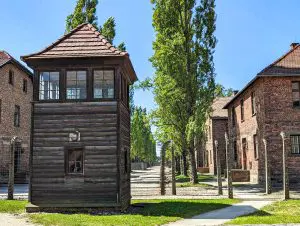 Although we’d personally recommend booking a tour which includes transport to Auschwitz, you can always make your own way there. Bus is the cheapest option with one-way tickets costing 15 PLN and a journey taking you 1 hour 45 minutes. You will find a number of bus companies leaving throughout the morning from the bus station next to Krakow train station, with drop offs close to the camp.
Although we’d personally recommend booking a tour which includes transport to Auschwitz, you can always make your own way there. Bus is the cheapest option with one-way tickets costing 15 PLN and a journey taking you 1 hour 45 minutes. You will find a number of bus companies leaving throughout the morning from the bus station next to Krakow train station, with drop offs close to the camp.
During our drive there, we passed the train station and noted that it wasn’t too far from Auschwitz. Tickets are about 20 PLN each way and it can take between an hour and a half to two hours depending on the number of stops. You may need transport from the station in Oswiecim, or you could walk between 20 to 30 minutes.
We thought we’d mention travelling by car, but most of us heading to a city break in Krakow won’t need to hire a car. This may be an option if you’re looking at going to a number of other locations outside of Krakow such as the Wieliczka Salt Mine.
As you can see each of these options may be slightly cheaper than a tour, but they bring some inconveniences which we wouldn’t recommend. The tour itself is a long day, so you want the transfer in and back to be as easy and relaxing as possible. Then add in the fact that by booking a tour, you are guaranteed a ticket into Auschwitz.
What Happened on the Day of Our Auschwitz-Birkenau Tour
Obviously, everyone’s experience will be different depending on a myriad of factors, such as the company you book with. But we thought we’d share our day with you, as probably it will be similar.
We walked from our apartment to the pickup location and the transport was already there. After we gave our names, showed our identification and paid the driver, we hopped onboard the minibus. After a couple of additional pickups, we started the journey to the museum. The drive there is incredibly pretty, through little villages with quaint wooden houses, very reminiscent of The Sound of Music.
Once you arrive at the museums carpark you will be given coloured stickers, which will indicate the tour group you are with. There will be a queue to enter the museum, and you will be required to go through a security search. Our advice is to not take rucksacks as they are not allowed in the museum.
Auschwitz I Concentration Camp
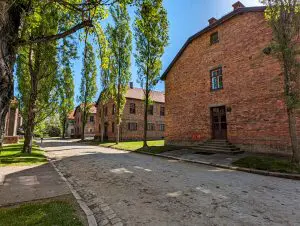 Because our bus arrived late, we had to go on the tour immediately, although we did nip to the toilet at the entrance quickly. You will meet your guide, be given a headset and details about what the tour will involve. We then walked past a small exhibition section and into a concrete walkway, which separates the museum entrance from the camp area. This walkway isn’t like any other, because as you make your way through, you will hear names of some of the victims. It is a poignant start to the tour and a reminder of the reason why you are there, to remember the people who died in the concentration camp.
Because our bus arrived late, we had to go on the tour immediately, although we did nip to the toilet at the entrance quickly. You will meet your guide, be given a headset and details about what the tour will involve. We then walked past a small exhibition section and into a concrete walkway, which separates the museum entrance from the camp area. This walkway isn’t like any other, because as you make your way through, you will hear names of some of the victims. It is a poignant start to the tour and a reminder of the reason why you are there, to remember the people who died in the concentration camp.
You walk out of the tall concrete tunnel, and you’re met with what we could only describe as a lush green area of trees and grass, which is broken up by buildings and fences. During the walk through the entrance to the concentration camp, the tour guide will explain everything you are seeing and the different uses of the buildings on the site. One of the very first things you will see is the entrance gate which is known all over the world, mainly because of the phrase displayed on top which says Arbeit macht frei, which translates to ‘work sets you free’.
From there you will make your way around the site and into the buildings. The knowledgeable guides bring the prisoners experiences to life with stories about the camp and what their day to day would have been like. This can be hard to listen to because the information is quite matter of fact; as it should be. Even if you’re knowledgeable about the events that occurred there, we’re sure you’ll still learn something new, we certainly did.
We don’t want to go into too much detail about everything you will see there, because we feel it is more impactful if you experience it yourself. But just be aware that there are photos shown and they can depict some horrific scenes.
The buildings throughout Auschwitz are now museums which display various exhibits. This will include demonstrations of where people lived and slept, the latrines and prison cells. Some of the most difficult exhibits are the artefacts left by prisoners and it includes suitcases with their names written on, pots and pans, shoes and even children’s clothing which we found incredibly emotional.
You will find that as you make your way around the camp, there are lots of other tour groups doing the same. This is fine when you’re outside, but it can be busy within the buildings, and you may have to move through faster than you would like. But there is so much to see that the tour guide will move you on quite quickly anyway. Also, some of the steps are quite worn within the buildings and not even, so take care as you go up and down any stairs.
One of the more difficult sights is the death wall, where you will see memorials and flowers laid to commemorate the thousands of people who were murdered there by the SS. But the one section we found the most disturbing was the medical area, which although you don’t go into the buildings, the stories alone left a lasting impression. We cannot begin to imagine the inhumane and barbaric acts which were carried out on the most vulnerable people.
As well as learning about the lives of the prisoners, the tour guide will discuss a little about the prison guards and more specifically Rudolph Hoess, who was commandant of the Auschwitz concentration camp. He ran the camp and lived in a villa just a few hundred yards from the gas chamber. After the Nuremberg Trials, he was sentenced to death by hanging, which was carried out next to the crematorium within the camp. You will be shown the spot where his sentence was carried out and then walked through the crematorium or gas chamber.
 Oddly you walk through the gas chamber back to front, so where you come out would have been where prisoners were made to undress. The chamber looks like a grassy mound with a chimney protruding from the top. We’ll be honest, we didn’t take a lot in as we walked through it, because the sheer fact we were walking through the concrete bunker was a little overwhelming. But you simply follow the group and then the tour guide will explain more when you reach the other side.
Oddly you walk through the gas chamber back to front, so where you come out would have been where prisoners were made to undress. The chamber looks like a grassy mound with a chimney protruding from the top. We’ll be honest, we didn’t take a lot in as we walked through it, because the sheer fact we were walking through the concrete bunker was a little overwhelming. But you simply follow the group and then the tour guide will explain more when you reach the other side.
This led us to the end of our time at Auschwitz, but after 90 minutes of standing, walking and listening to the tour guide, we felt ready for a break. There is a shop and toilets around the exit of this part of the museum and our bus driver was there to explain the next step of the tour and hand pre-ordered lunches to those who had bought them.
There isn’t much of a break between the first step of the tour and the second, if we remember correctly, it was about 30 minutes, and we had to be back on the bus. We had brought something to eat with us, so found a bench in the carpark and ate quickly, as well as nipping to the restroom.
Because we hadn’t researched this tour, we found it all a little confusing, especially hopping back on the bus. But there is a short drive of about 5 minutes from the Auschwitz I camp to Birkenau, which is known as Auschwitz II.
Birkenau – Auschwitz II
Birkenau, although it had many uses, was basically created as an extermination camp. It was the largest of the more than 40 camps and sub-camps that made up the Auschwitz complex. During its 3 years of operation, it was used as a prison camp for the slave labour who were transferred to work within German industry.
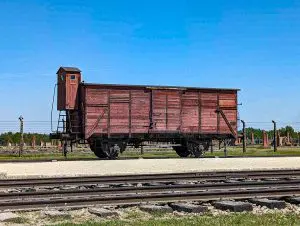 Most of the victims of Auschwitz died in Birkenau, its estimated about 90%, which would be approximately one million people. Although the majority of Birkenau was destroyed by the Nazis, there is still plenty to see when you visit.
Most of the victims of Auschwitz died in Birkenau, its estimated about 90%, which would be approximately one million people. Although the majority of Birkenau was destroyed by the Nazis, there is still plenty to see when you visit.
Our minibus parked up a short walk away from the museum entrance and we followed the driver who re-connected us with the same tour guide we had been with in Auschwitz I. As you’re walking up to the entrance you will be struck by two things. Firstly, the train tracks which have become synonymous with concentration camps, but also the looming guard towers.
After walking through the guard towers, you’re in a large open area which is where prisoners would be removed from the crammed wooden carriages and either selected for work or walked to their death. This was a difficult area for us emotionally to stand in, because we have seen many documentaries and films depicting the moment where prisoners are given a life-or-death sentence and told to go left or right. You will see the wooden carriages around the area and the tour guide will explain the journey prisoners will have gone through.
We will admit that as you look around the area it is huge, and you’ll already be tired (especially if it’s a hot day). Because much of Birkenau is made up of the same type of wooden sheds, you will only be taken to a small area of the camp. There are no gas chambers, merely foundations because they were destroyed. After walking through a gate of barbed wire fencing, we walked to the sheds and were shown the horrendous conditions the prisoners were kept in. The tour guide will provide details of how they slept, with a number of prisoners sharing one bunk. Also, how they would stay warm and basically survive.
The full tour is about an hour and yes you will be tired at this point, also make sure you watch your step because the ground is uneven. It’s quite obvious even now that Birkenau would have been hell on earth, and I don’t think it’s possible to grasp the deprivation experienced there.
There were so many moments we had to pause and take a breath; it was obvious how much it hit our entire group as everyone walked back to the car park in reflective silence.
Just an additional note, once the tour is finished you cannot walk around either site on your own. We then jumped back on the minibus and drove the hour and a half back to our pickup location in Krakow.
Should I Take Children to the Auschwitz Concentration Camp
This is a difficult one to answer, it will depend on the age of your child/children and whether they understand or are interested in World War II events and history. You as the parents would know as to whether your child would understand the significance of the site and the events which happened there. But also, it’s an incredibly early start and a long day of constant walking and standing, with very few rest breaks. Personally, we wouldn’t take young children there and during our visit we didn’t see any. But as for teenagers this again would depend on the child, this is an extremely emotive site, and you will see upsetting images and sights.
Our Tips for Visiting Auschwitz-Birkenau
 Just a few of our suggestions and tips to making your day easier and more comfortable.
Just a few of our suggestions and tips to making your day easier and more comfortable.
- Not only will you be walking over bumpy ground, as well as lots of steps. But you will also be standing for the entire time, with the average tour being 3 hours. Because of this we would recommend comfy shoes, because they can make a huge difference as to how much you enjoy the day. We’d also suggest wearing shoes that you don’t mind getting dirty, because most of the tour is outside on paths which are a mixture of dust, dirt and stones, so your footwear can get mucky. This is made worse if you visit and it is raining, or it has rained.
- Wear a hat or at least bring one with you, mainly because the majority of the tour will be conducted outside and if it’s a sunny day then you can get heatstroke easily.
- Similar to the point above, make sure you bring water with you and even snacks to nibble on throughout the tour. There are toilet stops available during the tour, but there isn’t an opportunity to buy refreshments when you’re in the camp. Because of this it makes sense to bring them with you.
- Something we didn’t consider, but we’d suggest bringing tissues with you. We’re not going to lie; this is going to be an emotional tour, and you may find yourself shedding a tear when you see the exhibits.
- Go to the toilet when you arrive at the museum, because there is only one within Auschwitz and one in Birkenau.
- Try to stay with your tour guide at all times, because if you stay behind for pictures or you want to read any displays, then you can lose your party easily. But also, the headsets would break up if there was a distance, meaning you couldn’t hear what was being said.
- Backpacks and handbags cannot exceed 30x20x10 cm, if you have a large bag, you can leave it in the luggage storage facility near the main entrance. We did have a small backpack, and we were allowed in with it.
- Consider what you are wearing, firstly because you’re outside for the majority of the tour. But also, to be respectful of the place you are visiting, this means it’s advisable to avoid anything too revealing.
Should I Do the Auschwitz-Birkenau Concentration Camp Tour?
Even though we found it incredibly emotional, we would always recommend visiting the museum. We’ve read many books about the camps and watched lots of movies and documentaries, but being there takes it to another level of reality.
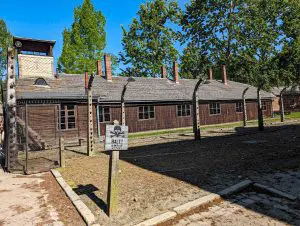 There’s no point in us minimising the impact of visiting a place like Auschwitz. Although we haven’t gone into too much detail of what you will see there, because we want you to experience it for yourself. Some of the images and exhibits can be distressing, we cried when we saw items of children’s clothing which are displayed in Auschwitz I. They are a lasting reminder of the horrors experienced by all victims of the holocaust, no matter their age.
There’s no point in us minimising the impact of visiting a place like Auschwitz. Although we haven’t gone into too much detail of what you will see there, because we want you to experience it for yourself. Some of the images and exhibits can be distressing, we cried when we saw items of children’s clothing which are displayed in Auschwitz I. They are a lasting reminder of the horrors experienced by all victims of the holocaust, no matter their age.
We found the day to have been well planned and easy to follow, even if at times we didn’t understand what was going on. The only problem is you have very little rest time, so be prepared to be on your feet for a big chunk of the day. The small half an hour break doesn’t seem enough to have a rest, eat and use the toilets, but we managed it. If you’re not restricted by diet, then it may be wise to prebook the lunch, but you can always bring nibbles such as biscuits or sweets to keep you going.
Our tour guide was incredibly knowledgeable, and we’ve read of other visitors stating the same. Many people in our group asked questions and our guide was able to answer them all.
One thing we were a little unsure about was taking pictures, as it felt a little distasteful when we walked around. Most people took pictures, and it was fine, with some taking selfies at the entrance gate. Just remember to be respectful, this is a site of immense sadness, and our behaviour should reflect that.
Hopefully this guide has helped answer any questions you may have about booking a tour and visiting Auschwitz. Make sure you tag us on Instagram if you end up going, we love to see what you’re up to as you tick off your bucket lists.
Related Guide – How to Start your Bucket List